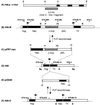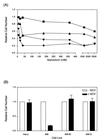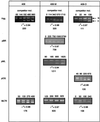Activity of the c-myc replicator at an ectopic chromosomal location
- PMID: 10409757
- PMCID: PMC84420
- DOI: 10.1128/MCB.19.8.5685
Activity of the c-myc replicator at an ectopic chromosomal location
Erratum in
- Mol Cell Biol 1999 Dec;19(12):8694
Abstract
DNA replication starts at multiple discrete sites across the human chromosomal c-myc region, including two or more sites within 2.4 kb upstream of the c-myc gene. The corresponding 2.4-kb c-myc origin fragment confers autonomously replicating sequence (ARS) activity on plasmids, which specifically initiate replication in the origin fragment in vitro and in vivo. To test whether the region that displays plasmid replicator activity also acts as a chromosomal replicator, HeLa cell sublines that each contain a single copy of the Saccharomyces cerevisiae FLP recombinase target (FRT) sequence flanked by selectable markers were constructed. A clonal line containing a single unrearranged copy of the transduced c-myc origin was produced by cotransfecting a donor plasmid containing the 2.4-kb c-myc origin fragment and FRT, along with a plasmid expressing the yeast FLP recombinase, into cells containing a chromosomal FRT acceptor site. The amount of short nascent DNA strands at the chromosomal acceptor site was quantitated before and after targeted integration of the origin fragment. Competitive PCR quantitation showed that the c-myc origin construct substantially increased the amount of nascent DNA relative to that at the unoccupied acceptor site and to that after the insertion of non-myc DNA. The abundance of nascent strands was greatest close to the c-myc insert of the integrated donor plasmid, and significant increases in nascent strand abundance were observed at sites flanking the insertion. These results provide biochemical and genetic evidence for the existence of chromosomal replicators in metazoan cells and are consistent with the presence of chromosomal replicator activity in the 2.4-kb region of c-myc origin DNA.
Figures








Similar articles
-
Multiple initiations in the c-myc replication origin independent of chromosomal location.DNA Cell Biol. 1998 Oct;17(10):885-96. doi: 10.1089/dna.1998.17.885. DNA Cell Biol. 1998. PMID: 9809750
-
Multiple functional elements comprise a Mammalian chromosomal replicator.Mol Cell Biol. 2003 Mar;23(5):1832-42. doi: 10.1128/MCB.23.5.1832-1842.2003. Mol Cell Biol. 2003. PMID: 12589000 Free PMC article.
-
Autonomous replication of a DNA fragment containing the chromosomal replication origin of the human c-myc gene.Nucleic Acids Res. 1990 Mar 11;18(5):1233-42. doi: 10.1093/nar/18.5.1233. Nucleic Acids Res. 1990. PMID: 2157194 Free PMC article.
-
Cis-acting effects of sequences within 2.4-kb upstream of the human c-myc gene on autonomous plasmid replication in HeLa cells.DNA Cell Biol. 1995 Jul;14(7):565-79. doi: 10.1089/dna.1995.14.565. DNA Cell Biol. 1995. PMID: 7626216
-
The Flp recombinase of the 2-microns plasmid of Saccharomyces cerevisiae.Prog Nucleic Acid Res Mol Biol. 1995;51:53-91. Prog Nucleic Acid Res Mol Biol. 1995. PMID: 7659779 Review. No abstract available.
Cited by
-
Replication-dependent instability at (CTG) x (CAG) repeat hairpins in human cells.Nat Chem Biol. 2010 Sep;6(9):652-9. doi: 10.1038/nchembio.416. Epub 2010 Aug 1. Nat Chem Biol. 2010. PMID: 20676085 Free PMC article.
-
The Chinese hamster dihydrofolate reductase replication origin beta is active at multiple ectopic chromosomal locations and requires specific DNA sequence elements for activity.Mol Cell Biol. 2001 Feb;21(4):1098-110. doi: 10.1128/MCB.21.4.1098-1110.2001. Mol Cell Biol. 2001. PMID: 11158297 Free PMC article.
-
Deficiency of the Fanconi anemia E2 ubiqitin conjugase UBE2T only partially abrogates Alu-mediated recombination in a new model of homology dependent recombination.Nucleic Acids Res. 2019 Apr 23;47(7):3503-3520. doi: 10.1093/nar/gkz026. Nucleic Acids Res. 2019. PMID: 30715513 Free PMC article.
-
Microsatellite break-induced replication generates highly mutagenized extrachromosomal circular DNAs.NAR Cancer. 2024 Jun 8;6(2):zcae027. doi: 10.1093/narcan/zcae027. eCollection 2024 Jun. NAR Cancer. 2024. PMID: 38854437 Free PMC article.
-
Site-specific DNA binding of the Schizosaccharomyces pombe origin recognition complex is determined by the Orc4 subunit.Mol Cell Biol. 2001 Dec;21(23):8095-103. doi: 10.1128/MCB.21.23.8095-8103.2001. Mol Cell Biol. 2001. PMID: 11689699 Free PMC article.
References
-
- Aladjem M I, Rodewald L W, Kolman J L, Wahl G M. Genetic dissection of a mammalian replicator in the human beta-globin locus. Science. 1998;281:1005–1009. - PubMed
-
- Berberich S, Trivedi A, Daniel D C, Johnson E M, Leffak M. In vitro replication of plasmids containing human c-myc DNA. J Mol Biol. 1995;245:92–109. - PubMed
-
- Bielinsky A K, Gerbi S A. Discrete start sites for DNA synthesis in the yeast ARS1 origin. Science. 1998;279:95–98. - PubMed
-
- Connolly A R, Cleland L G, Kirkham B W. Mathematical considerations of competitive polymerase chain reaction. J Immunol Methods. 1995;187:201–211. - PubMed
Publication types
MeSH terms
Substances
Grants and funding
LinkOut - more resources
Full Text Sources
Other Literature Sources
